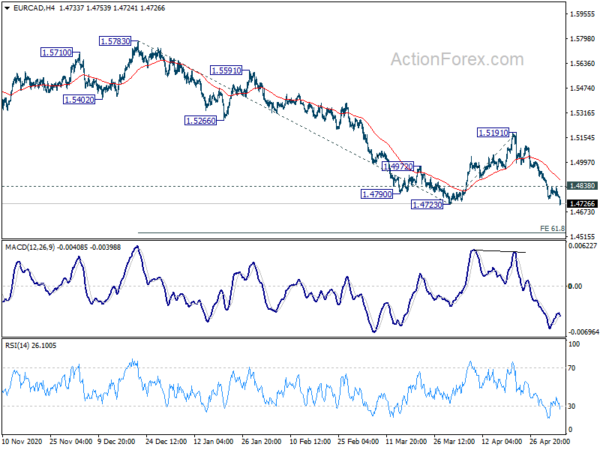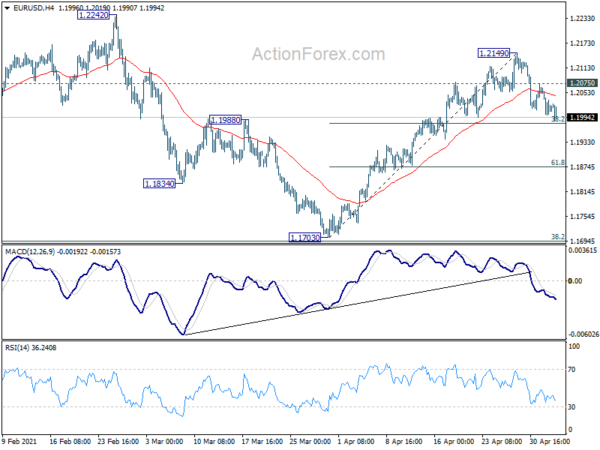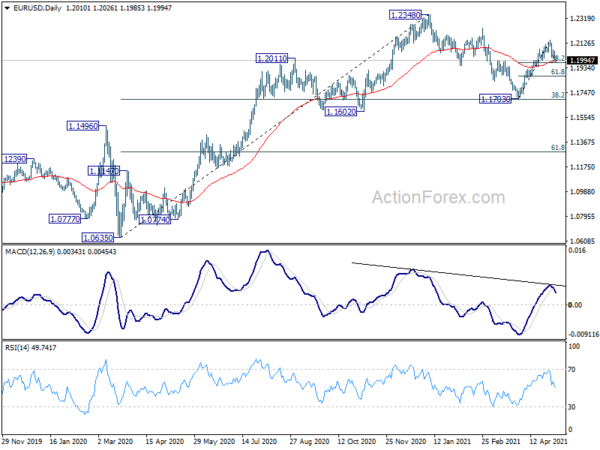Commodity currencies continue to trade as the stronger ones entering into US session. In particular, Canadian is helped by extended rally in oil prices. New Zealand Dollar continues to receive support from better than expected job data. Overall sentiments are positive with European stocks staging a rebound, while US futures point to recovery. Euro is currently the weakest one, followed by Swiss franc, and then Yen.
Technically, Canadian Dollar would be a focus in US session. In particular, EUR/CAD’s breach of 1.4723 support suggests that larger decline is resuming. Further rally is expected as long as 1.4838 minor resistance holds. Next target is 61.8% projection of 1.5783 to 1.4723 from 1.5191 at 1.4536. Eyes will also be on whether USD/CAD would break through 1.2265 temporary low to resume down trend.
In Europe, currently, FTSE is up 1.28%. DAX is up 1.53%. CAC is up 1.01%. Germany 10-year yield is up 0.025 at -0.211. Earlier in Asia, Hong Kong HSI dropped -0.49%. Singapore Strait Times dropped -0.80%. Japan and China were on holiday.
US ADP employment grew 742k in Apr, continues an upward trend of acceleration
US ADP employment grew 742k in April, below expectation of 808k. By company size, small businesses added 235k jobs, medium businesses 230k, large businesses 277k. By sector, goods-producing companies added 106k jobs, services-providing companies 636k.
“The labor market continues an upward trend of acceleration and growth, posting the strongest reading since September2020,” said Nela Richardson, chief economist, ADP. “Service providers have the most to gain as the economy reopens, recovers and resumes normal activities and are leading job growth in April. While payrolls are still more than 8 million jobs short of pre-COVID-19 levels, job gains have totaled 1.3 million in the last two months after adding only about 1 million jobs over the course of the previous five months.”
Eurozone PPI rose 1.1% om, 4.3% yoy in March, EU at 1.2% mom, 4.5% yoy
Eurozone PPI rose 1.1% mom, 4.3% yoy in March, above expectation of 0.9% mom, 4.0% yoy. For the month, Industrial producer prices increased by 2.0% in the energy sector, by 1.3% for intermediate goods, by 0.8% for non-durable consumer goods, by 0.3% for capital goods and by 0.2% for durable consumer goods. Prices in total industry excluding energy increased by 0.9%.
EU PPI rose 1.2% mom, 4.5% yoy. For the month, The highest increases in industrial producer prices were recorded in Ireland (+7.9%), Spain (+2.5%) and Portugal (+2.3%), while the only decrease was observed in Estonia (-1.6%).
Eurozone PMI composite finalized at 53.8, out of double-dip recession in Q2
Eurozone PMI Services was finalized at 50.5 in April, up from March’s 49.6. PMI Composite was finalized at 53.8, up from March’s 53.2. Latest data indicated fastest expansion since last July and the second best in over two-and -a-half years.
Chris Williamson, Chief Business Economist at IHS Markit said: “April’s survey data provide encouraging evidence that the eurozone will pull out of its double-dip recession in the second quarter. A manufacturing boom, fueled by surging demand both in domestic and export markets as many economies emerge from lockdowns, is being accompanied by signs that the service sector has now also returned to growth…
“The intensity of the rebound will naturally depend on the extent to which Covid restrictions can be removed – and some measures relating to international travel are likely to remain in place for some time to come – but experience in other countries hints that the bounce in domestic activity could be strong as pent up demand and savings power a surge in spending.”
New Zealand employment grew 0.6% in Q1, unemployment rate dropped to 4.7%
New Zealand employment grew 0.6% in Q1, above expectation of 0.3% qoq. Unemployment rate dropped to 4.7%, down from 4.9%, better than expectation of 4.9%. Labor force participation rate rose 0.1% to 70.4%. Labor cost index rose 0.4% qoq, above expectation of 0.3% qoq.
“There have been some gains in labour market outcomes, especially for women, over the past two quarters. However, annual changes indicate the labour market still hasn’t returned to pre-COVID-19 levels for men or women,” work, wealth, and wellbeing statistics senior manager Sean Broughton said.
Australia AiG construction dropped -2.7, still continued to power ahead
Australia AiG Performance of Construction Index dropped -2.7 pts to 59.1 in April, but stayed in expansion. Also, all four components of activity expanded strongly, with the activity index reaching a record high of 62.8. Employment dropped -3.9 to 59.2. New orders dropped -7.7 to 57.0. Supplier deliveries dropped -6.1 to 56.0.
Ai Group Head of Policy, Peter Burn, said: “Australia’s construction sector continued to power ahead in April led by house building and engineering construction.”
Also released, building permits rose 17.4% mom in March, well above expectation of 3.0% mom.
EUR/USD Mid-Day Outlook
Daily Pivots: (S1) 1.1988; (P) 1.2026; (R1) 1.2054; More….
EUR/USD’s pull back from 1.2149 continues today but outlook is unchanged. We’d still expect strong support from 38.2% retracement of 1.1703 to 1.2149 at 1.1979 to complete the pull back from 1.2149. On the upside, 1.2075 minor resistance will turn bias back to the upside for 1.2149 resistance. Break there will resume the rise from 1.1703 to 1.2242/2348 resistance zone. However, firm break of 1.1979 will bring deeper fall to 61.8% retracement at 1.1873.
In the bigger picture, rise from 1.0635 is seen as the third leg of the pattern from 1.0339 (2017 low). Further rally could be seen to cluster resistance at 1.2555 next, (38.2% retracement of 1.6039 to 1.0339 at 1.2516). This will remain the favored case as long as 1.1602 support holds. However, sustained break of 1.1602 will argue that whole rise from 1.10635 has completed. Deeper fall would be seen to 61.8% retracement of 1.0635 to 1.2348 at 1.1289.
Economic Indicators Update
| GMT | Ccy | Events | Actual | Forecast | Previous | Revised |
|---|---|---|---|---|---|---|
| 22:30 | AUD | AiG Performance of Construction Index Apr | 59.1 | 61.8 | ||
| 22:45 | NZD | Employment Change Q1 | 0.60% | 0.30% | 0.60% | |
| 22:45 | NZD | Unemployment Rate Q1 | 4.70% | 4.90% | 4.90% | |
| 22:45 | NZD | Labour Cost Index Q/Q Q1 | 0.40% | 0.30% | 0.50% | |
| 01:30 | AUD | Building Permits M/M Mar | 17.40% | 3.00% | 21.60% | 20.10% |
| 06:30 | CHF | CPI M/M Apr | 0.20% | 0.40% | 0.30% | |
| 06:30 | CHF | CPI Y/Y Apr | 0.30% | -0.20% | -0.20% | |
| 07:45 | EUR | Italy Services PMI Apr | 47.3 | 50 | 48.6 | |
| 07:50 | EUR | France Services PMI Apr F | 50.3 | 50.4 | 50.4 | |
| 07:55 | EUR | Germany Services PMI Apr F | 49.9 | 50.1 | 50.1 | |
| 08:00 | EUR | Eurozone Services PMI Apr F | 50.5 | 50.3 | 50.3 | |
| 09:00 | EUR | Eurozone PPI M/M Mar | 1.10% | 0.90% | 0.50% | |
| 09:00 | EUR | Eurozone PPI Y/Y Mar | 4.30% | 4.00% | 1.50% | |
| 12:15 | USD | ADP Employment Change Apr | 742K | 808K | 517K | 565K |
| 13:45 | USD | Services PMI Apr F | 63.1 | 63.1 | ||
| 14:00 | USD | ISM Services PMI Apr | 64.3 | 63.7 | ||
| 14:30 | USD | Crude Oil Inventories | -1.9M | 0.1M |
















